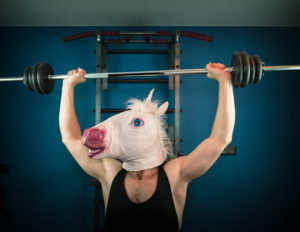 Fans of the likes of football, golf and tennis will no doubt feel that they love ‘pure’ sports, sports that are well-known throughout the world. Whilst it’s undoubtedly true that they are indeed sports that are played all over the planet, those that are lovers of more obscure sports would doubtless argue that they, in fact, are the people that love the more ‘pure’ sports on account of them being less popular.
Fans of the likes of football, golf and tennis will no doubt feel that they love ‘pure’ sports, sports that are well-known throughout the world. Whilst it’s undoubtedly true that they are indeed sports that are played all over the planet, those that are lovers of more obscure sports would doubtless argue that they, in fact, are the people that love the more ‘pure’ sports on account of them being less popular.
There are countless sports that fit into the category of being ‘weird’ or ‘strange’, include those that combine two already existing disciplines in order to create something entirely new. Chessboxing would be a good example of that phenomenon, seeing competitors alternate rounds of playing chess and punching each other. We will look at that as well as other weird and wonderful sports here.
Chessboxing
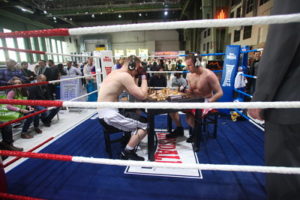 Where else to start but with chessboxing? Invented by the Dutch performance artist Iepe Rubingh, his idea come from the comic book Friod Equateur. In it the comic book artist, Enki Bilal, imagined a world in which boxers fight an entire match before sitting down to play chess. Rubingh thought that that would be impractical, instead believing that a competitive sport could be created by alternating the disciplines.
Where else to start but with chessboxing? Invented by the Dutch performance artist Iepe Rubingh, his idea come from the comic book Friod Equateur. In it the comic book artist, Enki Bilal, imagined a world in which boxers fight an entire match before sitting down to play chess. Rubingh thought that that would be impractical, instead believing that a competitive sport could be created by alternating the disciplines.
The sport was unveiled to the public at an art gallery called Platoon in September of 2003. Its creator, labelling himself Iepe the Joker, went up against Luis the Lawyer in the world middleweight chess-boxing title fight two months later. Iepe won because he caused his opponent such damage in the final round of boxing that he couldn’t figure out his moves to win the chess that the pair were playing.
There are six rounds of chess that last for four minutes, whilst the boxing rounds last for two minutes and there are five of them in total. The disciplines are alternated and there is a one-minute interval between each. The winner is determined by either knocking out their opponent in the ring or else getting checkmate on the board. In the event of no chess winner, the boxing matched can be decided according to points.
Underwater Hockey
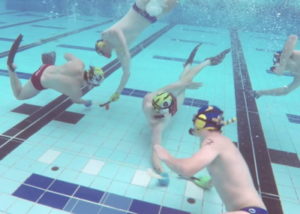 Also known as Octopush, the sport of underwater hockey asks teams to try to defeat each other by getting a puck into the goal of the opposing side. The key difference between underwater hockey and the variety of the sport played on ice, for example, is that it is played, well, under the water. In order to accommodate this the players wear diving masks and snorkels and the puck is weighted.
Also known as Octopush, the sport of underwater hockey asks teams to try to defeat each other by getting a puck into the goal of the opposing side. The key difference between underwater hockey and the variety of the sport played on ice, for example, is that it is played, well, under the water. In order to accommodate this the players wear diving masks and snorkels and the puck is weighted.
Whilst it’s far from the most spectator-friendly sport in existence, some of the matches are recorded using cameras and then broadcast. Because players are not allowed to use scuba gear, the main challenge is in moving from above the water to below it in order to have breath whilst trying to shift the puck. Whilst it might sound like a modern phenomenon, it was actually created by Alan Blake in England in 1954.
The sport is now played around the world, governed by the Confédération Mondiale des Activités Subaquatiques. The first World Championship of the sport was held in Canada in 1980, with the planned Championship of 1979 cancelled because of apartheid and international politics. Two teams of up to ten players compete, with six players playing at any one time and the rest used as rolling subs.
Cheese Rolling

Whilst far from being the most globally popular sport, the Cooper’s Hill Cheese-Rolling and Wake competition takes place every year on the Spring Bank Holiday. Located close to Gloucester, England, the event was traditionally held by and for the people of the local village of Brockworth. Nowadays it is a world-famous event, with competitors flying in from as far afield as Nepal, Australia and the United States of America to take part.
The cheese used for the event is Double Gloucester, which has to weigh between 7 and 9 pounds. It is sent rolling down the 200 yards of the hill, with competitors then chasing after it. The winner is the person that crosses the finish line first. Whilst the aim is to catch the cheese, it does have a 1-second head start and is able to reach speeds of up to 70 miles per hour, which can result in spectators being injured.
As well as taking international acclaim, the race winner also wins the cheese. In 2013 the cheese was replaced with a foam replica for reasons of safety, though the winner was still rewarded with actual cheese. Whilst the exact origins of cheese rolling as a competitive event can’t be nailed down, we do know that the first written reference to it was made in a message to the town crier in 1826.
Extreme Ironing

Whilst people with a mum from the north might well consider ‘extreme ironing’ to simply be a Sunday afternoon, those that engage in it know that it’s far more dangerous than that. Unlike many of the other sports on this list, extreme ironing isn’t one in which there are winners and losers. Instead, it is believed to be something of a tongue-in-cheek activity in which participants attempt to iron in the most extreme of circumstances.
Invented by Tony Hiam in 1980, the sport originated as a chance for Hiam to prove the futility of his brother ironing clothes even when camping. Having ironed in such strange places as the departure lounge of an airport and in a mountain lookout, Hiam began driving around with an ironing board and an iron in his boot in order to look for opportunities to do some extreme ironing.
Unaware of the sport’s origins, Leicester resident Phil Shaw combined his evening chore of ironing with his desire to go rock climbing in 1997, later embarking on an international tour to promote the activity. The 1st Extreme Ironing World Championships was held in 2002, though it’s entirely fair to say that it hasn’t yet developed into a truly competitive and world-famous sport that’s likely to be in the Olympics any time soon.
Quidditch
 Fans of the Harry Potter books, written by J. K. Rowling, will know all about Quidditch. They’ll also wonder how, exactly, it has become a real-life sport when you consider that the fictional version requires competitors to ride about on floating brooms. The answer, of course, is that the inventors have tweaked the invented game in order to allow it to be played in more practical terms.
Fans of the Harry Potter books, written by J. K. Rowling, will know all about Quidditch. They’ll also wonder how, exactly, it has become a real-life sport when you consider that the fictional version requires competitors to ride about on floating brooms. The answer, of course, is that the inventors have tweaked the invented game in order to allow it to be played in more practical terms.
A team sport that involves two teams with seven players on each, competitors have to keep a broomstick between their legs at all times. Played on a hockey rink-sized pitch, there are three hoops of varying heights at each end of the playing surface. Points are scored by chasers and keepers getting hold of the quaffle, which is a slightly deflated volleyball, and getting into one of the three hoops.
The aim of the game is to have more points than the opposition by the time that the snitch is released. When a seeker catches the snitch the game is over and the team that the seeker players for gains 30 points. It is a gender-neutral sport, with rules stating that each team must have a maximum of four people on each team that identify as the same gender. It is one of few sports that encourages non-binary players to get involved.
Tuna Tossing
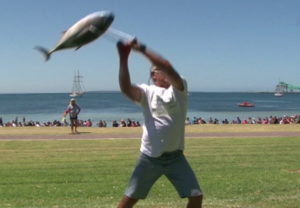 Whilst it might feel at times as though some of these sports involve people simply thinking of two random things and trying to combine them, tuna tossing has grown into a competitive sport. Originating in the small fishing community go Port Lincoln, South Australia, it was inspired by the local fishermen that tossed the fish they’d caught onto their trucks in a forceful manner.
Whilst it might feel at times as though some of these sports involve people simply thinking of two random things and trying to combine them, tuna tossing has grown into a competitive sport. Originating in the small fishing community go Port Lincoln, South Australia, it was inspired by the local fishermen that tossed the fish they’d caught onto their trucks in a forceful manner.
Sooner it was used as a way to make local festivals more interesting, with the winner being the person that is able to throw a fish weighing 20-pounds the furthest distance. Having been taking place since 1979, the modern iteration of the sport is a little bit cleaner than its origins thanks to the fact that the fish tossed is made of rubber instead of being a real one; at least for the non-purists.
The Tunarama Festival takes place every January, with Sean Carlin holding the record for the longest throw in the history of the event. He managed to throw his fish an incredible 37.23 metes. Participants have to be 18 or older, with the fish weighing between 8 and 10 kilograms. Throwers stand within a wide circle and must not leave it when throwing the fish, with the best throwers receiving monetary prizes.
Toe Wrestling
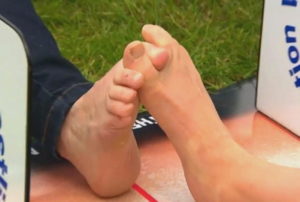 Eeny, meeny, miny, moe, how do you fancy wrestling with your toe? Perhaps somewhat unsurprisingly, this sport was invented by four drinkers at Ye Olde Royal Oak Inn in Staffordshire, England. Sat drinking in 1974 and bemoaning the fact that England struggled to produce world champions of any sport, they figured that the English would automatically become the best at a newly created sport no one else knew about.
Eeny, meeny, miny, moe, how do you fancy wrestling with your toe? Perhaps somewhat unsurprisingly, this sport was invented by four drinkers at Ye Olde Royal Oak Inn in Staffordshire, England. Sat drinking in 1974 and bemoaning the fact that England struggled to produce world champions of any sport, they figured that the English would automatically become the best at a newly created sport no one else knew about.
So it was that Pete Cheetham, Eddie Stansfield, Pete Dean and Mick Dawson stripped off their shoes and socks and began to wrestle using only their toes. The sport was decided upon after ear wrestling and push of war both failed. Dawson won the first ‘world championship’, defending his title the following year. Ironically, a Canadian won the competition in 1976 and the sport was briefly abandoned thereafter.
The rules of toe wrestling are similar to arm wrestling, with competitors trying to pin the opponent’s foot for three seconds whilst avoiding finding themselves in the same position. The sport involves three rounds and is played in a best of three format. Though the Olympic Committee refuses to acknowledge that it is a real sport, the World Toe Wrestling Championship takes place every year at the Bentley Brook Inn.
Cardboard Tube Duelling
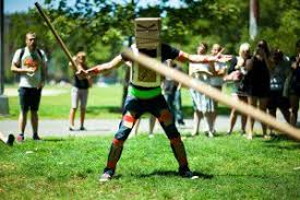 We promise we’re not making these things up, as evidenced by the existence of the Cardboard Tube Fight League. Based in Seattle, the sport involves either individuals or teams fighting against one another with cardboard tubes. The aim is to break the opponent’s cardboard tube whilst ensuring that your own remains intact. Events are hosted in the likes of Washington, California and Australia.
We promise we’re not making these things up, as evidenced by the existence of the Cardboard Tube Fight League. Based in Seattle, the sport involves either individuals or teams fighting against one another with cardboard tubes. The aim is to break the opponent’s cardboard tube whilst ensuring that your own remains intact. Events are hosted in the likes of Washington, California and Australia.
Created by Robert Easley after he remembered hitting friends and family with cardboard tubes as though they were swords, he decided to make a league of the sport in order to ensure that people are able to take themselves less seriously. The first event was hosted at Gas Works Park in Seattle in July of 2007, with local publication The Stranger calling it their ‘Pick Of The Week’ in terms of things to do.
There are different event types when it comes to cardboard tube duelling. Tournaments are the most common, involving between 24 and 64 participants and taking place over multiple stages. New tubes are not issued until after the second round, with three-person chaos bouts not being uncommon. In addition to tournaments, battles also take place and differ from tournaments because cardboard armour is allowed.
Man Versus Horse Marathon
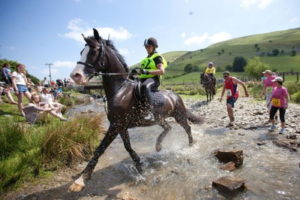 In a Welsh village in 1979, locals Gordon Green and Glyn Hones were having an argument; who would win a marathon, a man or a horse? Obviously they needed to find out, so ever since then an annual race is run over 22 miles and sees runners go up against riders on horse back. Whilst it might seem impossible for anything other than the horses to win, human competitors have done so more than once.
In a Welsh village in 1979, locals Gordon Green and Glyn Hones were having an argument; who would win a marathon, a man or a horse? Obviously they needed to find out, so ever since then an annual race is run over 22 miles and sees runners go up against riders on horse back. Whilst it might seem impossible for anything other than the horses to win, human competitors have done so more than once.
Whilst it’s a shorter distance than an official road-based marathon, the event is still a solid test for competitors and takes place in Llanwrtyd Wells, Wales every June. Other races also take part in Scotland and New Zealand, as well as in the US state of Arizona. Cyclists were allowed to take part from 1985, with Jacquie Phelan narrowly missing out that year. Tim Gould, a British cyclist, became the first to win the race in 1989.
The first time that a man racing on foot won the race was in 2004 when Huw Lobb was victorious thanks to his finishing time of 2 hours, 5 minutes and 19 seconds. He took home the prize money of £25,000, which had grown by £1,000 every year since the event’s inception. In 2013 the race was able to claim to be the ‘world’s largest horse race’ thanks to 44 horses competing.
Giant Pumpkin Kayaking
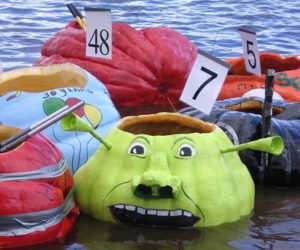
The last sport to mention that we’re definitely not making up is Giant Pumpkin Kayaking. Also known as the Windsor Pumpkin Regatta, the event takes place annually in October on Lake Pesaquid, Nova Scotia. The course is half a mile in length, with brightly coloured pumpkins the only form of flotation allowed. Founded by Danny Dill in 1999, Leo Swinamer of New Ross, Nova Scotia has won the race numerous times.
Believe it or not, the race is split into three different classes: motor, experimental and paddling. Whilst the latter is the most popular in terms of entries, the others also see competitors find different ways of trying to complete the journey. The sport gained notoriety in 2005 when Martha Stewart declared that she would be taking part, only to be delayed by weather and unable to compete.
Randomly, Windsor is not the first location to feature a pumpkin used as a craft. Instead, Wayne Hackney of Winchester, New Hampshire paddled in a pumpkin that he had grown in 1996. The regatta has, however, inspired numerous other regattas using pumpkins elsewhere in North America. The fastest time to complete the course was set by Frank Mueller in 2013, doing so in 5 minutes and 53 seconds.
